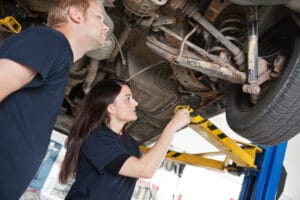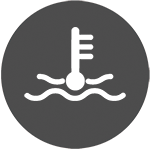Drivetrain

A vehicle drivetrain is an important system that controls power delivery from the engine to the wheels. It consists of several components that work together to transmit torque and provide motion to the wheels. Understanding the drivetrain is important for drivers and technicians alike, as it can impact vehicle performance, efficiency, and reliability.
The basic components of a vehicle drivetrain include the engine, transmission, driveshaft, differential, and axles. Each of these components plays a critical role in the transfer of power and motion from the engine to the wheels.
The engine is the primary source of power for the vehicle, and it is responsible for producing torque that is transferred to the transmission. The transmission, in turn, is responsible for controlling the speed and direction of the torque as it is delivered to the driveshaft.
The driveshaft is a long, rotating shaft that connects the transmission to the differential. It is usually made of steel and is designed to withstand the high torque and rotational speeds produced by the engine. The driveshaft must be precisely balanced to prevent vibration and ensure smooth power transfer.
The differential is a gearbox located between the driveshaft and the axles, and it is responsible for distributing torque to the wheels. It allows the wheels to rotate at different speeds, which is necessary when turning or driving on uneven surfaces. The differential is also designed to provide torque multiplication, which helps to increase the vehicle’s pulling power.
Finally, the axles are responsible for transmitting power from the differential to the wheels. They are typically made of steel and are designed to withstand the high stresses produced by the engine and the vehicle’s weight. The axles are also responsible for supporting the weight of the vehicle and providing a stable platform for the wheels.
There are several types of drivetrains, each with its own advantages and disadvantages. The most common types of drivetrains include front-wheel drive, rear-wheel drive, and all-wheel drive.
Front-wheel drive is a popular choice for small cars and compact SUVs. It is a simple and lightweight design that offers good fuel efficiency and handling. However, front-wheel drive can be limited in terms of traction and pulling power, especially in slippery or off-road conditions.
Rear-wheel drive is a common choice for larger cars, trucks, and performance vehicles. It offers good handling and pulling power, as well as better weight distribution and balance. However, rear-wheel drive can be less fuel-efficient than front-wheel drive and may be more difficult to handle in slippery conditions.
All-wheel drive is a popular choice for SUVs, crossovers, and sports cars. It offers excellent traction and handling in all types of conditions, making it a good choice for drivers who need versatility and performance. However, all-wheel drive can be more expensive and heavier than other types of drivetrains, which can impact fuel efficiency and handling.
In addition to these basic types of drivetrains, there are also hybrid and electric drivetrains. These drivetrains use a combination of gasoline or electric power to provide torque and motion to the wheels. Hybrid drivetrains are becoming increasingly popular, as they offer good fuel efficiency and low emissions, while electric drivetrains are ideal for drivers who want zero emissions and maximum efficiency.
When it comes to maintenance and repair, the drivetrain can be a complex and expensive system to work on. Problems with it can cause a variety of symptoms, including noise, vibration, loss of power, and difficulty shifting. Regular maintenance and inspections are important to keep it in good condition and prevent major repairs.
In conclusion, the vehicle drivetrain is a critical system that controls power delivery and motion to the wheels. Understanding the components and types of it can help drivers and technicians make informed decisions about vehicle performance and efficiency.
Visit Pete’s Auto Haus to have a comprehensive check on your car to ensure safety while driving.



















